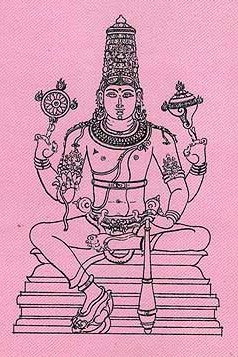Siddhantarahasya, Siddhāntarahasya, Siddhanta-rahasya: 4 definitions
Introduction:
Siddhantarahasya means something in Hinduism, Sanskrit. If you want to know the exact meaning, history, etymology or English translation of this term then check out the descriptions on this page. Add your comment or reference to a book if you want to contribute to this summary article.
In Hinduism
Pancaratra (worship of Nārāyaṇa)
Source: archive.org: Catalogue of Pancaratra Agama TextsSiddhāntarahasya (सिद्धान्तरहस्य) refers to the “secret truth (of Hiraṇyagarbha) (=Brahmā)”, as discussed in the fifth chapter of the Agastyasaṃhitā (agastya-suīkṣṇa-saṃvāda edition), an ancient Pāñcarātra Āgama text dealing with the worship of Rāma, Sītā, Lakṣmaṇa and Hanumān. Description of the chapter [pārvatyupadeśa]: Sutīkṣṇa asks Agastya what Pārvatī did then, and how Śiva went about helping her to learn the mantra, etc. Agastya replies that from that time on Pārvatī started to follow the secret truth of Hiraṇyagarbha [hairayaṇyagarbha-siddhāntarahasya] by emptying her mind of everything but thoughts of Rāma. But, he adds, so successful was Pārvatī’s concentration that she became desireless, and this worried Śiva; for, so Śiva reasoned, their purpose within creation was to come together as prakṛti and puruṣa and produce progeny. [...]

Pancaratra (पाञ्चरात्र, pāñcarātra) represents a tradition of Hinduism where Narayana is revered and worshipped. Closeley related to Vaishnavism, the Pancaratra literature includes various Agamas and tantras incorporating many Vaishnava philosophies.
Languages of India and abroad
Sanskrit dictionary
Source: Cologne Digital Sanskrit Dictionaries: Aufrecht Catalogus Catalogorum1) Siddhāntarahasya (सिद्धान्तरहस्य) as mentioned in Aufrecht’s Catalogus Catalogorum:—jy. written in 1520 by Gaṇeśa Daivajña, son of Keśava. Io. 2041. W. p. 237. Cambr. 57. L. 2024. Khn. 90. K. 226. B. 4, 126. Ben. 27. 31. Bik. 295. Pheh. 8. Bonn. 311. Burnell. 76^b. Bhk. 35. Bhr. p. 28. Oppert. Ii, 4575. 8204. Quoted by Nṛsiṃha Oxf. 337^b.
—[commentary] Oudh. Xiv, 52.
—[commentary] by Mallāri. L. 2025. B. 4, 128. Pheh. 8. Rādh. 35. Burnell. 77^a.
—[commentary] by Viśvanātha. Io. 92. 183. 2041. L. 1339. 2456. K. 226. B. 4, 128. Bik. 338. Np. I, 144. Ii, 112. Jac. 696. Bhk. 35. Poona. 311. Oppert. 6843. 6900. 7943. Ii, 517. 1964. 3141. Peters. 3, 397.
—[commentary] Udāharaṇa. Pheh. 8. Oudh. Xiv, 48.
—by Ḍhuṇḍhirāja. Ben. 27.
—by Viśvanātha. Cambr. 58. Paris. (B 187). L. 2456. B. 4, 128. 208. Ben. 27. Oudh. Xii, 22. Xiii, 62. Xiv, 52. Xviii, 40. Bhr. 306. Peters. 1, 115.
Siddhāntarahasya has the following synonyms: Grahalāghava.
2) Siddhāntarahasya (सिद्धान्तरहस्य):—[anonymous] Paris. (B 201).
3) Siddhāntarahasya (सिद्धान्तरहस्य):—vedānta, by Kalyāṇarāya. B. 4, 106.
—and—[commentary] by Jagannātha. K. 134.
—by Vallabhācārya. B. 4, 106.
—[commentary] by Puruṣottama. B. 4, 106.
—[commentary] Siddhāntarahasyavṛttikārikā by Haridāsa. B. 4, 106. A Siddhāntarahasya is quoted by Caṇḍīdāsa on Kāvyaprakāśa.
4) Siddhāntarahasya (सिद्धान्तरहस्य):—[nyāya] by Kṛṣṇamitra. Oudh. X, 18.
—by Jagadīśa. Oppert. Ii, 3982.
—by Mathurānātha. Quoted by him in his
—[commentary] on the Tattvacintāmaṇi 2, 129. 271. 284. A Siddhāntarahasya is also quoted by Raghunātha in the Anumānadīdhiti.
5) Siddhāntarahasya (सिद्धान्तरहस्य):—a second name of the Grahalāghava by Gaṇeśa. Compare Sūryasiddhāntarahasya.
6) Siddhāntarahasya (सिद्धान्तरहस्य):—by Gaṇeśa Daivajña, son of Keśava. Fl. 265. Io. 1983. 1990 ([fragmentary]). 2041. 2114 ([fragmentary]). 2181. Oudh. Xx, 130. Stein 158.
—[commentary] Manoramā vṛtti. Rgb. 837.
—[commentary] by Mallāri. Gov. Or. Libr. Madras 25. Io. 1983. Oudh. Xx, 110. Peters. 4, 34. Rgb. 809. Stein 158.
—[commentary] Udāharaṇa by Viśvanātha. Io. 92. 183. 2041. 2181. 2545. 2606. Peters. 4, 34. Rgb. 877. Stein 158. Grahalāghave Candrasūryaparvādhikāraḥ. Stein 158. Grahalāghavasāraṇī by Gaṇeśa. Stein 158.
Siddhāntarahasya has the following synonyms: Grahalāghava.
7) Siddhāntarahasya (सिद्धान्तरहस्य):—[nyāya] Io. 660. 1633.
8) Siddhāntarahasya (सिद्धान्तरहस्य):—bhakti, by Vallabhācārya. Io. 1068.
—[commentary] Peters. 4, 24.
—[commentary] by Puruṣottama. Peters. 4, 24.
9) Siddhāntarahasya (सिद्धान्तरहस्य):—jy. by Gaṇeśa, son of Keśava. Ulwar 1750.
—[commentary] by Mallāri. ibid.
—[commentary] Udāharaṇa by Viśvanātha. Ulwar 1751.
Siddhāntarahasya has the following synonyms: Grahalāghava.
10) Siddhāntarahasya (सिद्धान्तरहस्य):—bhakti, by Raghunātha. Ulwar 1604.
11) Siddhāntarahasya (सिद्धान्तरहस्य):—by Gaṇeśa, son of Keśava. Ak 856 (inc.). 857 (up to the chapter on Nakṣatramālā). Il. Jl. L.. 970-975. 981 (in Hindī). Tod 8. C. Grahalāghavodāharaṇa by Viśvanātha, son of Divākara. As p. 60. 224. Bd. 864. L.. 976 -980.
Siddhāntarahasya has the following synonyms: Grahalāghava.
12) Siddhāntarahasya (सिद्धान्तरहस्य):—by Vallabhācārya. Peters. 6, 310. C. Siddhāntarahasyārthakārikā. Ak 804. C. by Puruṣottama. Ak 803.
13) Siddhāntarahasya (सिद्धान्तरहस्य):—[nyāya] by Mathurānātha. As p. 224.
Source: Cologne Digital Sanskrit Dictionaries: Monier-Williams Sanskrit-English DictionarySiddhāntarahasya (सिद्धान्तरहस्य):—[=siddhānta-rahasya] [from siddhānta > sidh] n. Name of [work]
[Sanskrit to German]
Sanskrit, also spelled संस्कृतम् (saṃskṛtam), is an ancient language of India commonly seen as the grandmother of the Indo-European language family (even English!). Closely allied with Prakrit and Pali, Sanskrit is more exhaustive in both grammar and terms and has the most extensive collection of literature in the world, greatly surpassing its sister-languages Greek and Latin.
See also (Relevant definitions)
Partial matches: Rahasya, Siddhanta.
Ends with: Anupasamharisiddhantarahasya, Arthapattisiddhantarahasya, Asadharanasiddhantarahasya, Kevalanvayisiddhantarahasya, Kevalavyatirekisiddhantarahasya, Lingakaranatasiddhantarahasya, Paramarshasiddhantarahasya, Rajayogasiddhantarahasya, Satpratipakshasiddhantarahasya, Suryasiddhantarahasya, Upadhidushakatabijasiddhantarahasya, Vaiyakaranasiddhantarahasya, Vivahasiddhantarahasya, Vyatirekisiddhantarahasya.
Full-text: Vaiyakaranasiddhantarahasya, Satpratipakshasiddhantarahasya, Lingakaranatasiddhantarahasya, Vivahasiddhantarahasya, Vyatirekisiddhantarahasya, Paramarshasiddhantarahasya, Kalyanaraya, Grahalaghava, Ganeshvara acarya, Hairanyagarbha, Ganesha daivajna, Vallabhacarya, Krishnamitra acarya, Mathuranatha, Jagannatha, Raghunatha, Mathuranatha tarkavagisha.
Relevant text
Search found 3 books and stories containing Siddhantarahasya, Siddhāntarahasya, Siddhanta-rahasya, Siddhānta-rahasya; (plurals include: Siddhantarahasyas, Siddhāntarahasyas, rahasyas). You can also click to the full overview containing English textual excerpts. Below are direct links for the most relevant articles:
Chaitanya Bhagavata (by Bhumipati Dāsa)
Verse 2.28.9 < [Chapter 28 - The Lord’s Pastime of Accepting Sannyāsa]
A History of Indian Philosophy Volume 4 (by Surendranath Dasgupta)
Part 9 - Works of Vallabha and his Disciples < [Chapter XXXI - The Philosophy of Vallabha]
A History of Indian Philosophy Volume 5 (by Surendranath Dasgupta)
Part 1 - The Literature and History of Southern Śaivism < [Chapter XXXIV - Literature of Southern Śaivism]